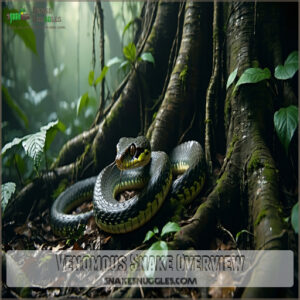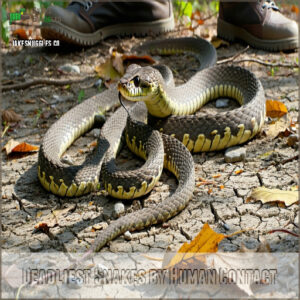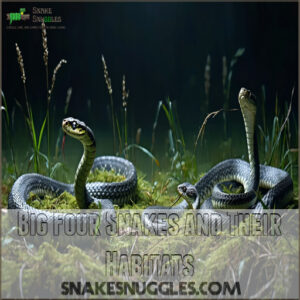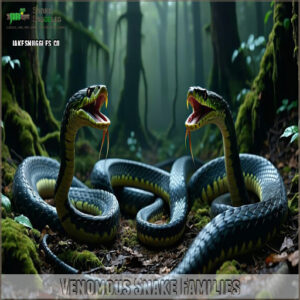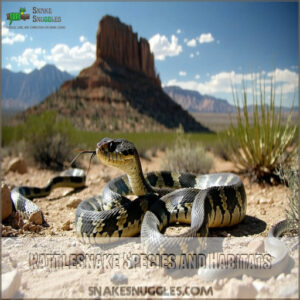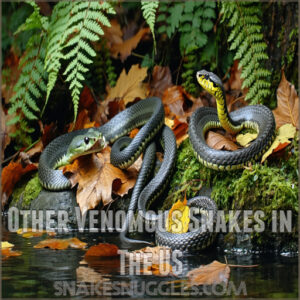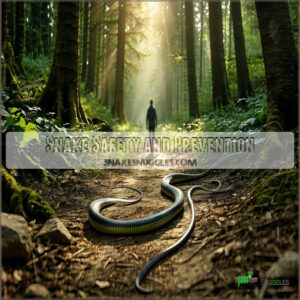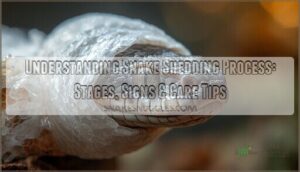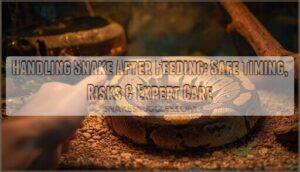This site is supported by our readers. We may earn a commission, at no cost to you, if you purchase through links.
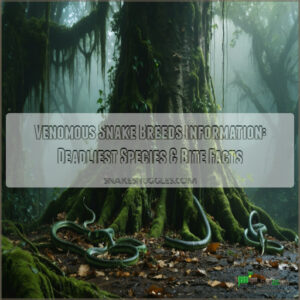
The Inland Taipan tops the charts as nature’s deadliest cocktail mixer, while the saw-scaled viper claims the most human casualties.
These fascinating creatures use their venom primarily for hunting and self-defense, not just to ruin your hiking trip.
Each year, around 5.4 million people have close encounters of the serpentine kind, making it vital to know your local species and their habits.
Understanding their behavior patterns might just be your secret weapon for peaceful coexistence.
Table Of Contents
- Key Takeaways
- Venomous Snake Overview
- Deadly Venomous Snakes
- Venomous Snake Families
- Venomous Snakes in The US
- Snake Safety and Prevention
- Frequently Asked Questions (FAQs)
- What is the most venomous snake breed?
- What are some facts about venomous snakes?
- What is the top 10 most venomous snake?
- Which venomous snake kills the most humans?
- How do snakes make and regenerate their venom?
- Can venomous snakes control their venom output?
- What determines if a snakebite becomes fatal?
- How do baby snakes differ in venom potency?
- Why do some snakes have different colored venom?
- Conclusion
Key Takeaways
- You’ll find that out of 3,700 snake species, about 600 are venomous snakes, and they use their venom primarily for hunting and self-defense, so it’s crucial to know your local species and their habits.
- The most venomous snakes, like the Inland Taipan, can kill with a single bite, but it’s the saw-scaled viper that claims the most human lives annually, so you should be aware of the species that are most likely to encounter humans.
- When it comes to snakebites, you must act fast, as timely medical attention can substantially impact survival chances – you should contact emergency services, keep the patient calm, and document the bite time and snake description.
- You can avoid venomous snake encounters by being smart about your preparation, sticking to well-maintained trails, wearing sturdy boots, and learning to identify venomous snake characteristics, so you can enjoy nature while minimizing the risk of a deadly encounter.
Venomous Snake Overview
When you think of venomous snakes, it’s fascinating to realize that out of 3,700 species worldwide, only about 600 are equipped with venom.
These specialized predators have evolved powerful chemical weapons to defend themselves and subdue prey, making them both deadly and essential to their ecosystems.
Global Venomous Snake Species
Snakes are fascinating but deadly creatures.
Out of 3,700 species worldwide, about 600 are venomous, with 200 capable of killing humans.
They thrive in diverse snake habitats across the globe.
Venomous snakes use venom for both predation and defense, as detailed on the venomous snakes page.
Here’s a quick breakdown:
- Species classification includes Elapidae, Viperidae, and others.
- Some snakes inject venom efficiently with fangs.
- The most venomous snakes depend on venom types and behavior.
Venom Characteristics and Potency
Venom composition isn’t random—snake venom is a finely-tuned cocktail designed to immobilize prey or fend off threats.
Its toxicity levels depend on potency factors like LD50, with lower LD50 meaning deadlier venom.
The saw-scaled viper, highlighted on this deadliest snakes list, may be responsible for the most human deaths.
Venomous snake breeds, such as the Inland Taipan, boast unmatched venom potency.
Snake venom attacks the bloodstream, tissues, or nerves, making it both fascinating and life-threatening.
Venomous Snakebite Impacts and Statistics
Every 10 seconds, someone falls victim to a snakebite .
Global statistics reveal a staggering 5.4 million people face snakebite encounters yearly, with up to 138,000 deaths and 400,000 permanent disabilities.
You’ll find most cases in tropical regions, where medical resources are scarce.
Children and agricultural workers bear the highest risk, with kids facing more severe venom effects due to their smaller size.
Deadly Venomous Snakes
You’ll find that deadly venomous snakes come in different breeds worldwide, from the highly potent Inland Taipan with the lowest LD50 of 0.025 mg/kg to the saw-scaled viper that causes the most human fatalities annually.
While the most toxic snakes aren’t always responsible for the most deaths, you should know that the "Big Four" snakes – including the saw-scaled viper, Russell’s viper, Indian cobra, and common krait – cause the highest number of fatalities due to their frequent contact with humans in populated areas.
Top Venomous Snakes by LD50
Measuring venom potency through LD50 tells you exactly how lethal a snake’s toxic cocktail can be.
Scientists use this scale to rank the most venomous snakes, where lower numbers mean deadlier venom.
- The inland taipan leads with an LD50 of 0.025 mg/kg, enough to kill 100 people in under 45 minutes
- Coastal taipan follows with 0.106 mg/kg lethal doses
- Black mamba packs a punch at 0.30 mg/kg
- King cobra’s venom rates 1.80 mg/kg
Deadliest Snakes by Human Contact
Consistently leading the charts in fatal snake encounters, the saw-scaled viper causes roughly 30,000 deaths annually.
You’ll notice that deadliest snakes aren’t always the most venomous—they’re the ones frequently crossing paths with humans, especially in areas with limited healthcare.
Many venomous snake characteristics contribute to their danger level, including venom potency, aggressiveness, and habitat proximity to humans.
Russell’s Viper follows close behind, while the Indian Cobra ranks third in snakebite fatalities, particularly affecting agricultural workers and rural communities.
Big Four Snakes and Their Habitats
While certain snakes pose risks worldwide, the "Big Four" snakes dominate snakebite statistics in South Asia.
These venomous snake species thrive in specific snake habitats that overlap with human settlements:
- Russell’s Viper prefers grasslands and farmlands
- Indian Cobra adapts to both urban areas and agricultural zones
- Common Krait hunts at night in residential spaces
Understanding their habitat preferences helps predict where you’re most likely to encounter these deadly species, making it easier to avoid dangerous snake-human interactions.
Venomous Snake Families
You’ll find venomous snakes grouped into four main families: Atractaspididae, Colubridae, Elapidae, and Viperidae, each with their own unique fang structures and venom delivery methods.
While you’re learning about these fascinating creatures, you’ll discover how their specialized fangs work like natural syringes to inject modified saliva that can immobilize or kill prey, which is a unique aspect of their biology.
Atractaspididae and Elapidae Characteristics
While we’ve explored the deadliest snakes worldwide, let’s examine two fascinating venomous snake families.
Atractaspididae, found in Africa and the Middle East, have unique erectile front fangs and can cause severe tissue damage.
Their cousins, the Elapidae family, including cobras and mambas, pack a powerful neurotoxic punch through permanently erect front fangs.
These snakes’ venom delivery systems and fang structures have evolved perfectly for their hunting needs, utilizing severe tissue damage as a mechanism to immobilize their prey.
Viperidae and Colubridae Families
The Viperidae family stands out with their triangular heads and heat-sensing facial pits.
You’ll find these pit vipers across diverse habitats worldwide.
In contrast, the Colubridae family makes up an impressive 75% of all snake species.
While most colubrids are non-venomous, they’ve adapted to various environments – from underground burrows to treetop homes .
Their remarkable diversity shows nature’s ability to fill every ecological niche.
Venom Delivery and Fang Structure
The precision of a snake’s fang anatomy works like a natural syringe system.
You’ll find venom glands tucked beneath the eye, where they produce and store toxic cocktails before sending them through specialized ducts.
For more in-depth information, explore this detailed venomous snakes resource.
These ducts connect to hollow fangs in pit vipers, while some venomous snake species sport grooved teeth for venom flow.
Snake teeth have evolved into either enclosed canals or surface channels, perfectly designed for their delivery mechanism.
Venomous Snakes in The US
You’ll find about 20 species of venomous snakes in the United States, including rattlesnakes, copperheads, cottonmouths, and coral snakes.
While most U.S. states have at least one venomous snake species, you can safely explore Alaska, Hawaii, Maine, and Rhode Island without worry, as they’re completely snake-free.
Rattlesnake Species and Habitats
Across North American snake habitats, you’ll spot 22 different rattlesnakes mastering their terrain.
In desert habitats, Western Diamondbacks show off their patterns while Sidewinders perfect their unique moves across the sand.
Up in the Rocky Mountains and forest understory, Timber Rattlesnakes adapt to cooler climates.
A variety of rattlesnake species products are available for enthusiasts.
Each species displays distinct rattlesnake behavior, from the massive Eastern Diamondback‘s warning signals to the Prairie Rattlesnake’s grassland hunting strategies.
Other Venomous Snakes in The US
Beyond rattlesnakes, you’ll need to watch for several other venomous snakes in the US.
The Cottonmouth, known for its aggressive defense habits, lurks near water bodies.
Eastern Copperheads blend perfectly with fallen leaves, making them hard to spot.
The brightly colored Coral snakes, though shy, pack potent venom.
Each species has unique habitats and behaviors, from swamps to woodlands.
Understanding venom types is essential for effective snakebite prevention and treatment.
Snake-Free US States and Regions
Looking to escape US venomous snakes entirely? Alaska stands as your safest bet – it’s the only completely snake-free state due to its icy climate.
Hawaii, Maine, and Rhode Island follow closely, with Hawaii maintaining its snake-free status through strict biosecurity.
In other regions, you’ll find snake-free zones above 10,000 feet elevation, and urban areas typically show reduced snake populations through careful wildlife management.
Snake Safety and Prevention
You’ll find that preventing dangerous snake encounters is much simpler than you’d think, with basic precautions like watching where you step and keeping your yard clear of debris.
When you do spot a snake, you’ll want to remember the key rule that’s saved countless lives: stay calm and slowly back away, since most snakes won’t chase or attack unless they feel threatened, following the principle to slowly back away.
Timely Medical Attention and Treatment
A snakebite is a life-threatening emergency that demands immediate medical intervention.
Your swift response and proper first aid procedures can substantially impact survival chances.
When every second counts, here’s your essential protocol:
- Contact emergency services immediately and locate the nearest antivenom-stocking facility
- Keep the patient calm and immobile to slow venom spread
- Document bite time and snake description for treatment guidance
- Remove constricting items near the bite area
- Call poison control (1-800-222-1222) for additional guidance
Having a Snake Bite Kit on hand can be vital in such situations.
Avoiding Venomous Snake Encounters
While hiking in snake territory, your best defense is smart preparation .
Stick to well-maintained trails and wear sturdy boots with long pants for effective snake bite prevention.
Learning to identify venomous snake characteristics is essential for avoiding potentially dangerous encounters.
Make noise as you walk, and stay alert near rocky outcrops or tall grass where venomous snakes often hide.
For wilderness survival, maintain proper spacing when stepping over logs, and give any snake you spot plenty of room.
Recognizing Venomous Snake Species and Behaviors
While venomous snake identification might seem tricky, you’ll spot warning signs once you know what to look for.
Watch for triangular heads, rattles, or blotchy patterns.
Most venomous snakes display distinct behavioral patterns – they’ll coil defensively, flatten their heads, or raise their bodies in an S-shape before striking.
In their habitat, they often leave distinctive tracks and prefer hiding in rocky or dense areas.
Understanding a Venomous Snake Guide is essential for effective snake safety and prevention measures.
Frequently Asked Questions (FAQs)
What is the most venomous snake breed?
Out of 3,700 snake species worldwide, the Inland Taipan stands as nature’s deadliest serpent.
You’ll find this snake in Australia, packing venom that’s potent enough to kill 100 humans with just one bite.
What are some facts about venomous snakes?
Did you know there are over 600 venomous snake species, but only 200 can harm humans.
Their venom isn’t just deadly—it’s a survival tool, helping them hunt and defend themselves in the wild.
What is the top 10 most venomous snake?
Dangerous as nature’s needlework, the Inland Taipan, Dubois’ Sea Snake, Eastern Brown Snake, and King Cobra top the list.
Add the Black Mamba and five others, each armed with venom designed for precision.
Which venomous snake kills the most humans?
The saw-scaled viper claims the most lives annually, with roughly 30,000 fatalities.
Its aggressive nature and proximity to humans in rural areas make it a silent killer, striking swiftly before victims often realize the danger.
How do snakes make and regenerate their venom?
Venom glands produce venom, a mix of proteins and enzymes, like spit with a deadly twist.
Snakes regenerate venom after use through specialized cells, ensuring they’re always ready for hunting or defense.
Can venomous snakes control their venom output?
Yes, venomous snakes can control their venom release.
They often inject full venom when hunting but might use less—or even "dry bites" without venom—when defending themselves, saving their venom for survival needs.
What determines if a snakebite becomes fatal?
Picture a single bite—what makes it fatal?
It depends on venom potency, bite location, the amount injected, your age, health, and how quickly you get medical help.
Time’s the enemy—don’t wait to act!
How do baby snakes differ in venom potency?
Baby snakes pack a surprising punch!
Their venom can be just as potent—or even more concentrated—than adults’, since they’ve yet to regulate how much they inject.
Don’t underestimate their small size; they’re no joke!
Why do some snakes have different colored venom?
Some snakes’ venom changes color due to unique proteins, enzymes, and environmental influences, like diet or habitat.
It’s like nature’s chemistry lab, where each snake tailors its venom blend for hunting, defense, or survival needs.
Conclusion
Fearlessly facing facts, you’ve learned about venomous snake breeds information, discovering the deadliest species and their potent venom.
You now know how to navigate nature, avoiding venomous encounters.
Remember, understanding venomous snake breeds information is key to peaceful coexistence with these fascinating creatures.

